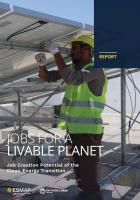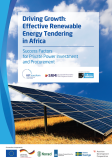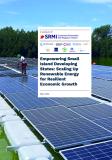Publications
The global transition to clean energy must accelerate if global warming is to be limited to 1.5°C and the effects of climate change mitigated. For the energy sector, the transition involves replacing fossil fuels with clean sources of energy and electrifying traditionally unelectrified areas (such as transport, heating, and industrial processes) while working toward universal access to clean energy services.
Disruptive Change in the Economy
Disruptive changes in production and consumption in the economy will result from phasing out traditional fossil-fuel industries and promoting sustainable energy technologies. To bring evidence to bear on this issue, the World Bank’s Energy Sector Management Assistance Program (ESMAP) implemented a program of analytical work from 2020 to 2023.
ESMAP's Analytical Program
Entitled “Estimating the Job Creation Potential of the Clean Energy Transition,” it assessed the job creation potential of the clean energy transition in low- and middle-income countries. In view of the limited applicability of the literature to the energy transition for developing economies and data constraints that preclude an ex post analysis, a computable general equilibrium model was developed to simulate, ex ante, the economywide employment impacts of clean energy interventions characterizing the energy transition in a sample of strategically important Sub-Saharan African countries.
Modeling and Limitations
While modeling can indicate likely high-level outcomes, it sheds little light on the mechanisms by which clean energy projects create jobs, which is important for policy design. Modeling also abstracts from spatial, temporal, and skills frictions that arise in real labor markets.
Complementary Case Studies
Therefore, to complement the modeling and understand how clean energy interventions create jobs in developing countries and also characterize the jobs created, detailed case studies of selected World Bank–supported clean energy projects were carried out, supplemented by deep dives into jobs created by productive use of electricity in mini grids and insights on the labor transition options for workers of coal-fired power plants. The findings, conclusions, and recommendations of this program of analytical work are presented in this report.
Explore More
Case Studies
Energy Sector Management Assistance Program (ESMAP). 2024. Jobs for a Livable Planet: Job Creation Potential of the Clean Energy Transition. © Washington, DC: World Bank. http://hdl.handle.net/10986/40962. License: CC BY 3.0 IGO.




